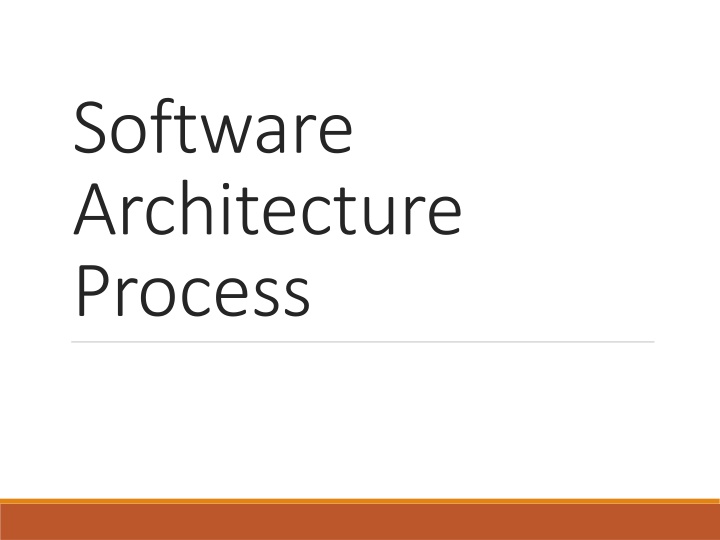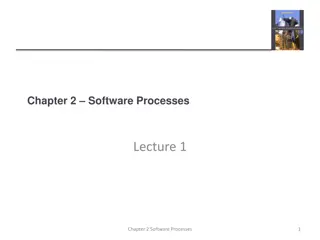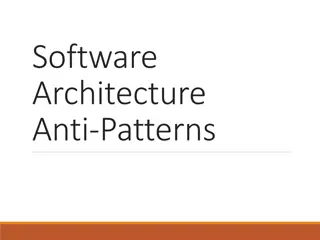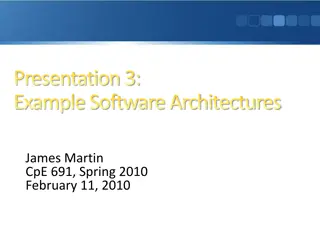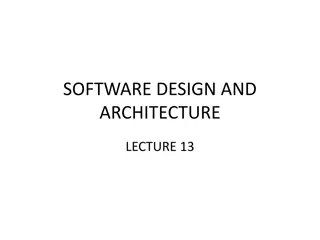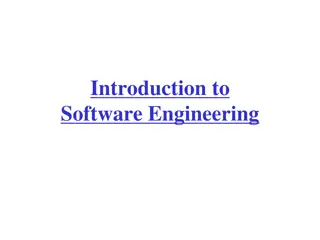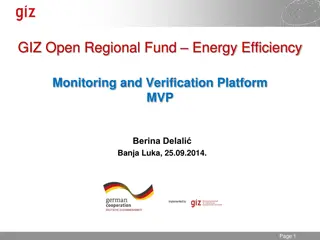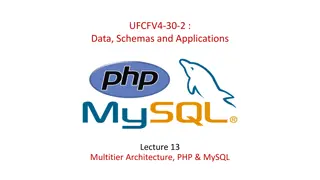Software Architecture Process Model: A General Overview
A detailed look into the software architecture process model, including architectural analysis, synthesis, evaluation, and repeatable processes. Learn about the key stages and methodologies involved in designing software architecture effectively.
Download Presentation

Please find below an Image/Link to download the presentation.
The content on the website is provided AS IS for your information and personal use only. It may not be sold, licensed, or shared on other websites without obtaining consent from the author.If you encounter any issues during the download, it is possible that the publisher has removed the file from their server.
You are allowed to download the files provided on this website for personal or commercial use, subject to the condition that they are used lawfully. All files are the property of their respective owners.
The content on the website is provided AS IS for your information and personal use only. It may not be sold, licensed, or shared on other websites without obtaining consent from the author.
E N D
Presentation Transcript
Software Architecture Process
A General Architecture Process Model C. Hofmeister, et al., A general model of software architecture design derived from five industrial approaches, Journal of Systems and Software, 80:106-126, 2007. R I T Software Engineering
Architectural Analysis Define the problems the architecture must solve. Inputs: Architectural Concerns: Interests which pertain to the system s development, its operation or any other aspects that are critical to one or more shareholders Context: The setting and circumstances of developmental, operational, political and other influences upon the system Output: Architecturally Significant Requirements: A requirements upon a software system which influences its architecture R I T Software Engineering
Architectural Synthesis Proposes architectural solutions to a set of Architecturally Significant Requirements Input: Architecturally Significant Requirements Output: Candidate Architectural Solutions: Design decisions about the structure of the software R I T Software Engineering
Architectural Evaluation Ensure that the architectural designs decisions made are the right ones Inputs: Architecturally Significant Requirements Candidate Architectural Solutions Outputs: Validated Architecture: A subset of candidate architectures that are consistent with the Architecturally Significant Requirements R I T Software Engineering
Repeatable Processes for Software Architecture Analysis, Synthesis, and Evaluation are the core concepts of many architectural methodologies. Examples: Attribute-Driven Design RUP 4+1 Views Business Architecture Process and Organization (BAPO/CAFCR) No one process is best each has its strengths and weaknesses. R I T Software Engineering
Attribute Driven Design R I T Software Engineering
Design Purpose Primary Functionality Quality Attributes Architectural Concerns Constraints Step 1: Review Inputs Step 2: Establish Iteration Goal Step 3: Choose Elements to Refine From previous round of iterations OR from existing system Step 4: Choose Design Concepts Iterate if necessary Step 5: Instantiate Architectural Elements Step 6: Record Design Decisions Step 7: Review Design (Refined) Software Architecture Design
ADD Step 1 Review Inputs: Ensure the architecture drivers are available and correct Design Purpose The goal of this round of Architectural Design Evaluate opportunities Design the foundation of the system Augment the current architecture Primary Functionality Functionality that is critical to achieve the business goals that motivate the development of the system Quality Attributes The subset of QAs this round is focused on Derived from ASRs, focus on measurable or testable qualities Constraints Non-negotiable concerns Existing systems Architectural Concerns Things that need to be considered as part of the architectural design, often not captured by traditional requirements Overall System Structure Allocation of modules to teams Issues that come from design reviews Design Purpose Primary Functionality Quality Attributes Architectural Concerns Constraints R I T Software Engineering
ADD Step 2 Establish Iteration Goal by Selecting Drivers Waterfall development model consists of one round, therefore the goal is to satisfy all architectural activities Iterative development (Agile) model consist of multiple rounds; each round should focus on a specific goal Round 1 of a Greenfield System in a mature field may be to select the overall Reference Architecture Round 1 of a Greenfield System in a new, evolving field may be to develop a prototype architectural model based on the key Drivers Round 1 of a Brownfield System may focus on how the existing architecture extends to support the new functionality Later rounds may focus on a specific area Security, Performance, etc. Where the specific area is based on the Drivers R I T Software Engineering
ADD Step 3 Choose One or More Elements of the System to Refine Satisfying drivers requires making architectural design decisions Based on the Drivers selected during Step 2, identify the elements that require additional refinement. Potential types of refinement: Decomposition Composition Improve / extend existing elements For a Greenfield system the first iteration will start with the system context diagram and refining / defining it For Brownfield systems the first iteration may focus on understanding the existing system and the elements you will need to be working with R I T Software Engineering
ADD Step 4 Choose One or More Design Concepts that Satisfy the Selected Drivers Leverage existing solutions, combine and adapt them as necessary Reference Architectures A model architecture to solve a common problem, for instance a Client-Server model for providing a Web Service or AUTOSAR a reference model for software in automobiles Architectural Design Patterns Conceptual solutions to reoccurring design problems, the Layer pattern is a commonly used example Deployment Patterns How to physically structure a system for deployment, Load Balanced Cluster Tactics Design decisions that influence the control of a quality attribute R I T Software Engineering
ADD Step 5 Instantiate Architectural Elements, Allocate Responsibilities and Define Interfaces Apply the design concept to the element(s) under consideration For instance if we re focused on the enabling user interactions with the system and we ve chosen the architectural pattern Model-View- Controller Where does each component reside? What is the model we need to convey to address Usability? What parts of the system does the controller need to interact with? We may not know the answers to all these questions and future iterations may be required to further refine them R I T Software Engineering
ADD Step 6 Sketch Views and Record Design Decisions Document it Design decisions have been made, the results are likely diagrams and supporting rationale Now is the time to capture that information, before its lost R I T Software Engineering
ADD Step 7 Perform Analysis of Current Design and Review Iteration Goal and Achievement of Design Goal Review the architecture against the drivers and overall system goals If the drivers are met and the design purpose is satisfied, declare victory and move forward If there is still work to complete to meet the design purpose, continue on to the next set of drivers If the drivers are not met, determine what needs to change and revise the architecture R I T Software Engineering
RUP 4+1 View R I T Software Engineering
BAPO/ CAFCR R I T Software Engineering
Scenarios Web application for banking Control system for driverless car Describe a: Describe a: - Performance Attribute - Performance Attribute - Security Attribute - Security Attribute - Integrity Attribute - Safety Attribute - Availability Attribute - Reliability Attribute What would be a good example of a Portability Attribute? R I T Software Engineering
Examples If you are building a desktop application - Connects to online brokerage system List some assumptions List some dependencies R I T Software Engineering
